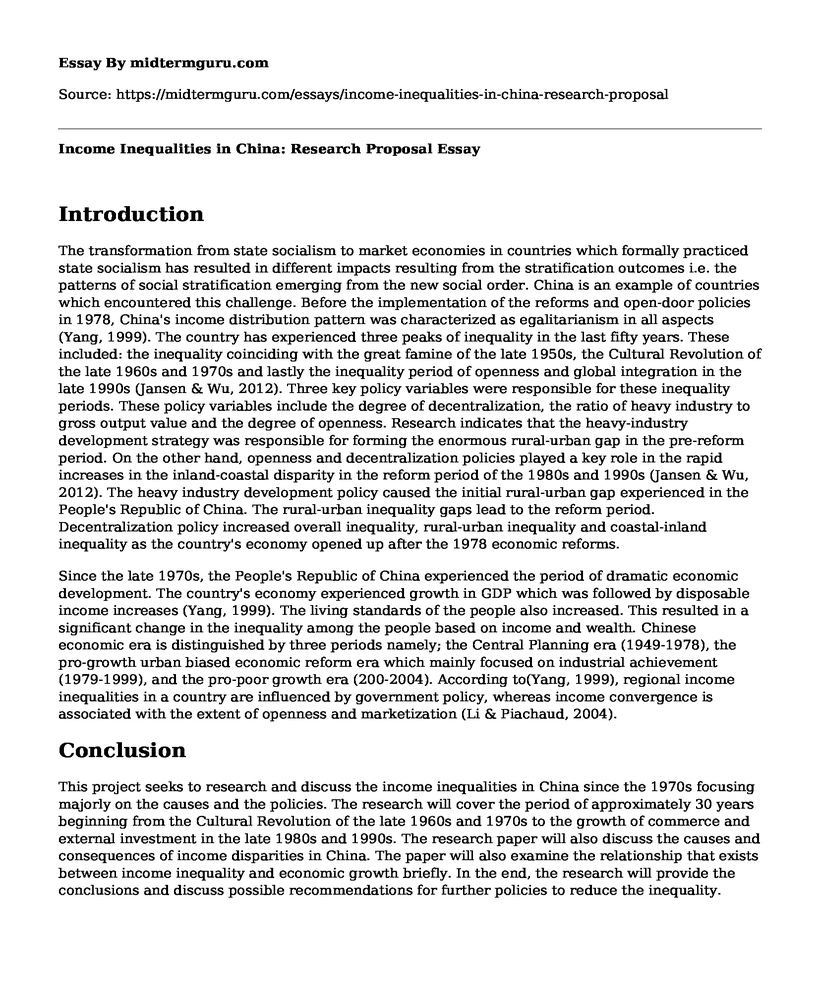Introduction
The transformation from state socialism to market economies in countries which formally practiced state socialism has resulted in different impacts resulting from the stratification outcomes i.e. the patterns of social stratification emerging from the new social order. China is an example of countries which encountered this challenge. Before the implementation of the reforms and open-door policies in 1978, China's income distribution pattern was characterized as egalitarianism in all aspects (Yang, 1999). The country has experienced three peaks of inequality in the last fifty years. These included: the inequality coinciding with the great famine of the late 1950s, the Cultural Revolution of the late 1960s and 1970s and lastly the inequality period of openness and global integration in the late 1990s (Jansen & Wu, 2012). Three key policy variables were responsible for these inequality periods. These policy variables include the degree of decentralization, the ratio of heavy industry to gross output value and the degree of openness. Research indicates that the heavy-industry development strategy was responsible for forming the enormous rural-urban gap in the pre-reform period. On the other hand, openness and decentralization policies played a key role in the rapid increases in the inland-coastal disparity in the reform period of the 1980s and 1990s (Jansen & Wu, 2012). The heavy industry development policy caused the initial rural-urban gap experienced in the People's Republic of China. The rural-urban inequality gaps lead to the reform period. Decentralization policy increased overall inequality, rural-urban inequality and coastal-inland inequality as the country's economy opened up after the 1978 economic reforms.
Since the late 1970s, the People's Republic of China experienced the period of dramatic economic development. The country's economy experienced growth in GDP which was followed by disposable income increases (Yang, 1999). The living standards of the people also increased. This resulted in a significant change in the inequality among the people based on income and wealth. Chinese economic era is distinguished by three periods namely; the Central Planning era (1949-1978), the pro-growth urban biased economic reform era which mainly focused on industrial achievement (1979-1999), and the pro-poor growth era (200-2004). According to(Yang, 1999), regional income inequalities in a country are influenced by government policy, whereas income convergence is associated with the extent of openness and marketization (Li & Piachaud, 2004).
Conclusion
This project seeks to research and discuss the income inequalities in China since the 1970s focusing majorly on the causes and the policies. The research will cover the period of approximately 30 years beginning from the Cultural Revolution of the late 1960s and 1970s to the growth of commerce and external investment in the late 1980s and 1990s. The research paper will also discuss the causes and consequences of income disparities in China. The paper will also examine the relationship that exists between income inequality and economic growth briefly. In the end, the research will provide the conclusions and discuss possible recommendations for further policies to reduce the inequality.
References
Chen, Z., & Zhou, Y. (2005). Income distribution during system reform and economic development in China: The status and trend of income inequality of Chinese residents. Nova Publishers.
Jansen, W., & Wu, X. (2012). Income inequality in urban China, 1978-2005. Chinese Sociological Review, 45(1), 3-27.
Jian, T., Sachs, J. D., & Warner, A. M. (1996). Trends in regional inequality in China (No. w5412). National Bureau of Economic Research.
Kanbur, R., & Zhang, X. (2005). Fifty years of regional inequality in China: a journey through central planning, reform, and openness. Review of Development Economics, 9(1), 87-106.
Li, B., & Piachaud, D. (2004). Poverty and inequality and social policy in China.
Yang, D. T. (1999). Urban-biased policies and rising income inequality in China. American Economic Review, 89(2), 306-310.
Zhou, Y., & Song, L. (2016). Income inequality in China: causes and policy responses. China Economic Journal, 9(2), 186-208.
Cite this page
Income Inequalities in China: Research Proposal. (2022, Sep 25). Retrieved from https://midtermguru.com/essays/income-inequalities-in-china-research-proposal
If you are the original author of this essay and no longer wish to have it published on the midtermguru.com website, please click below to request its removal:
- Essay on Legalizing Marijuana in the US
- Literature Review on Prevention in the Vulnerability to Substance Abuse - Paper Example
- Research Paper on US Immigration Program
- Veteran Suicide: A Growing Tragedy - Research Paper
- Drug & Substance Abuse: Examining Homelessness & Its Impact - Essay Sample
- Bias: Cognitive Shortcuts Leading to Prejudgments and Discrimination - Essay Sample
- Exploring England's Unique Culture, Values, Traditions & History - Essay Sample







